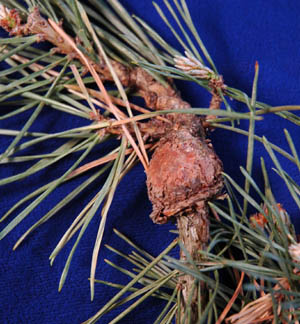Two Rusts That Form Galls | |
|---|---|
| May 23, 2006 | |
Have you ever seen a gall associated with a rust disease? There are many rust diseases on various plant hosts. Most of us are familiar with rusts that form pustules and rusty-looking spores. These pustules might be found on leaves or stems. Examples include leaf rust on corn, rust of daylily, hollyhock rust, or rust on turfgrasses. Most are also familiar with cedar–apple rust, which causes rust galls on the evergreen host. There is also a group of rust diseases that causes galls on pines. We call these the pine gall rusts. The galls form as a swelling in the stem. You have to remove the stem to remove the gall. Image 060602 shows one of these galls before spores are evident. Eventually, rust pustules and spores are evident on the gall. We have seen the pine gall rusts more frequently in the last several years. The disease is not a widespread problem, but one that you should know about to stop its spread. Eventually, rust pustules and spores are evident on the gall. We have seen the pine gall rusts more frequently in the last several years. The disease is not a widespread problem, but one that you should know about to stop its spread. The two rusts of pine are pine–oak gall rust and pine–pine gall rust. An alternate host is not needed for pine–pine gall rust. The fungus causing pine–oak gall rust (Cronartium quercuum) requires two different hosts to complete its life cycle. In Illinois, the primary coniferous host is Scotch pine, but Jack, Austrian, mugo, ponderosa, and red pines may also be infected. Deciduous hosts include red, pin and bur oaks. Symptoms on pine include swollen areas on the branches, lumps or galls measuring up to 4 inches in diameter, and slowed growth. Mature galls often have white to yellow, blisterlike ridges (fruiting bodies) that rupture through the bark and produce yellowish spores. Severe infections may result in witches’-broom (multiple shoots growing from a gall), death of branches, and possibly death of the entire tree. Symptoms on oak leaves are similar to the symptoms of rust on crabapple. Small dark brown spots with yellow borders are visible on the upper leaf surfaces, and fruiting structures and spores develop on the underside of infected leaves. In the spring, mature galls on the pine host release wind-blown spores that infect expanding oak leaves. About one week after infection, orange spores are released from the underside of infected oak leaves, causing additional oak leaf infections. Two to 3 weeks later, hairlike structures are produced on the underside of infected leaves, and different spores are released that infect pine needles, succulent stems, and expanding candles. New pine infections take 2 to 4 years to develop into mature galls that can release spores capable of infecting oak leaves. Pine–pine gall rust (also called western gall rust) is caused by Endocronartium harknessii. You may also see the fungus as Peridermium harknessii. In Illinois, the primary host is Scotch pine, but Jack and ponderosa pines may also be infected. Pine–pine gall rust is very similar to pine–oak gall rust in severity, symptoms, and formation of galls. However, pine–pine gall rust does not infect oaks and does not need two hosts to complete its life cycle. The galls of pine–pine rust appear covered in a continuum of fissures and spores. The fissures do not make as complete a blanket of spores with pine–oak rust. To avoid the pine rust galls, purchase seedlings and young pines from a reputable source and inspect the trees prior to planting. However, keep in mind that even close inspection is not foolproof, as it will be 1.5 to 2 years before you can detect an infection. Although the field symptoms of these two rusts are virtually indistinguishable on pine, there are microscopic differences in the spores from the pine galls. While on-site, it may be helpful to examine nearby oak hosts for evidence of rust lesions, indicating the presence of pine–oak rust. Infected pine branches, galls, and/or whole trees should be removed before spring because the rust galls release infectious yellow–orange spores each spring. There are two fungicide active ingredients available to protect pines from infection: triadimefon and mancozeb. Triadimefon is sold as Bayleton or Strike. Bayleton may not be used on plants grown for sale or other commercial use. Strike is labeled for nursery use only. Mancozeb is sold as Dithane, Fore, Lesco Mancozeb, Pentathlon, or Protect. Because pine–oak gall rust has a few extra steps in the spring infection cycle, peak pine infection will likely be later than for pine–pine gall rust. The literature indicates that the pine-infecting spores are released 2 to 3 weeks after the first orange spores develop on the undersides of oak leaves. | |
| Author: | Bruce Paulsrud Nancy Pataky |
